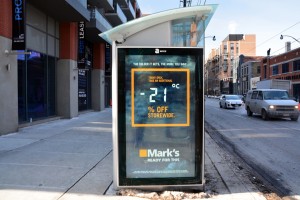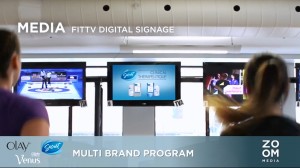How digital is transforming OOH
April 14th, 2015 | Rosanne Caron, President, OMAC/COMB

There’s no question that it’s harder than ever to grab people’s attention. Aided by technology (read: smartphones), consumers are constantly connected and able to research products, plan and make purchase decisions while on the go. With so much content coming at them, it has become easier to reject or ignore messages. But it turns out not everyone is walking around with their heads in the clouds. In fact, recent studies suggest the street remains a fertile ground for reaching consumers. According to reports by the likes of COG Research and Millward Brown, people are significantly more alert when outside their home, resulting in higher attention levels and receptiveness to advertising.
In this context, out-of-home advertising has an important role to play in driving purchase decisions. And the expansion of digital out-of-home (DOOH) networks is providing a new tool for advertisers striving to reach consumers in creative and engaging ways .
For those not up to speed, digital is transforming OOH. These are early days in the medium’s evolution, but five recent campaigns demonstrate the impact the platform can have.
Mark’s deep (freeze) discounts
DOOH is making it possible to create more personalized and tailored communications that leverage weather, events and social activity. That’s how Mark’s recently turned a common Canadian experience – waiting at a bus stop in the brutal cold – into a sales opportunity. The lower the temperature dropped, the deeper the discount on Mark’s clothing. This was demonstrated with bus shelter ads that tracked the changing temperature and showed the corresponding discount.
Lexus’ car-spotting game
The activation of campaigns in real-time ensures greater impact and relevancy to audiences. Car manufacturer Lexus used DOOH to track the brand of cars driving past, triggering a personalized message encouraging the driver to switch to a Lexus.
Billboards, installed across Australia at high-traffic sites, have been programmed to identify the brand, model and colour of approaching vehicles. Once identified, the billboard flashes a message aimed at the driver, such as “Hey white Audi driver, it’s time to Crossover. This is the New Lexus NX.” Other factors, including time of day, weather and traffic conditions are used as well to tailor messages, such as: “Hey black Merc driver, the heavens have opened. This is the new Lexus NX.”
Women’s Aid displays the healing power of attention
Interactive campaigns can create strong brand connections with consumers. A digital billboard for Women’s Aid helped raise awareness of domestic violence and how the charity helps to save lives.
Facial recognition technology was used to identify when people actively paid attention to an image of a bruised woman on the billboard in London, England. As more people took notice of the image of the woman, her bruises slowly healed, demonstrating to passersby that they can help confront domestic violence by not turning a blind eye. Those who looked at the billboard got feedback via a live feed that ran along the bottom of the ad as a visual tickertape, registering an increasing number of viewers.
Women’s Aid #lookatme campaign from Ocean Outdoor on Vimeo.
P&G and W Network go to the source
 The contextual environment and targeting capabilities of DOOH provides unique opportunities as well. Procter & Gamble created a multi-brand environment for Olay, Secret and Venus in fitness clubs that utilized digital screens and sampling to create awareness and generate trial among active female consumers. Meanwhile, W Network’s DIY show, Games of Homes, reached renovators with train wraps and digital boards located in close vicinity to home renovation and supply stores.
The contextual environment and targeting capabilities of DOOH provides unique opportunities as well. Procter & Gamble created a multi-brand environment for Olay, Secret and Venus in fitness clubs that utilized digital screens and sampling to create awareness and generate trial among active female consumers. Meanwhile, W Network’s DIY show, Games of Homes, reached renovators with train wraps and digital boards located in close vicinity to home renovation and supply stores.
DOOH is also serving as a link between the real and virtual world by driving search and activating social media conversations about brands. Almost six out of 10 (59%) Canadian mobile subscribers have taken action after seeing an OOH ad, according to comScore’s MobiLens study. The most common actions taken are seeking more information about a product or service, and talking to friends or family.
DOOH will continue to evolve in the future through the use of big data and emerging technologies. This will lead to greater personalization and customization of messages in the future, while providing marketers with metrics to evaluate the success of their campaigns.
Rosanne Caron
Rosanne Caron is both President of the Out-of-Home Marketing Association of Canada (OMAC) and the Canadian Out-of-Home Measurement Bureau (COMB). On April 16, Caron will be presenting a webinar on the evolution of OOH, including the integration of mobile and social media into the medium.
To register for the webinar, email Davina Wong at .
Complimentary for ACA members only




